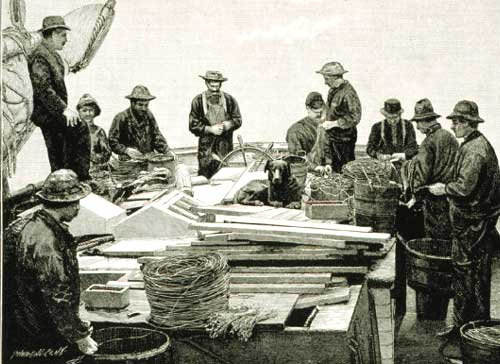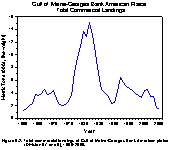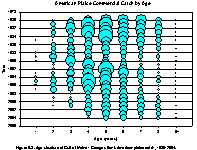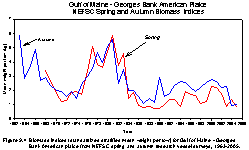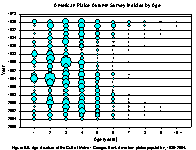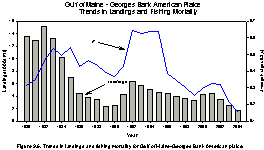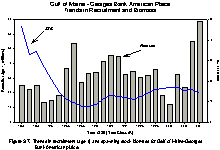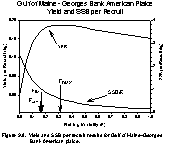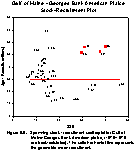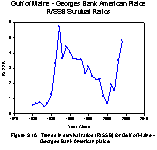
|
Status of Fishery Resources off the Northeastern US NEFSC - Resource Evaluation and Assessment Division | |||
| |||
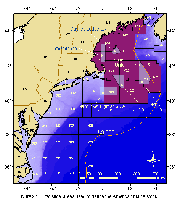 Figure 9.1 Statistical Areas Used |
Distribution, Biology and Management
The American plaice or dab, Hippoglossoides platessoides, is a large mouthed, "right handed" flounder, distributed along the Northwest Atlantic continental shelf from southern Labrador to Rhode Island in relatively deep waters (Collette and Klein-MacPhee 2002). Off the U.S. coast, American plaice are managed as a single stock in the Gulf of Maine-Georges Bank region (Figure 9.1). The greatest commercial concentrations exist between 90 and 182 m (50 and 100 fathoms). Maturation begins between ages 2 and 3, but most individuals do not reach sexual maturity until age 4 (O’Brien et al. 1993). Spawning occurs in spring, generally during March through May. Growth is rather slow; 3 year old fish are normally between 22 and 28 cm (9 to 11 in.) in length, and weigh between 90 and 190 g (0.2 to 0.4 lb). After age 4, females grow faster than males (Sullivan 1982). American plaice from Georges Bank have faster growth at age than fish from the Gulf of Maine (Esteves and Burnett 1993). |
The principal commercial
fishing gear used to catch American plaice is the otter trawl. Recreational
and foreign catches are insignificant. The U.S. fishery is managed
under the New England Fishery Management Council's Northeast Multispecies
Fishery Management Plan (FMP). Under this FMP, American plaice are
included in a complex of 15 groundfish species managed by time/area
closures, gear restrictions, minimum size limits, and, since 1994,
by direct effort controls including a moratorium on permits and
days-at-sea restrictions. Amendment 9 established biomass rebuilding
targets, (NEFMC 1998) and defined control rules which specified
target fishing mortality rates and corresponding rebuilding time
horizons. Amendment 13 implemented formal rebuilding plans within
specified time frames based on revised biomass and fishing mortality
targets derived by the Working Group on Re-Evaluation of Biological
Reference Points for New England Groundfish (NEFSC 2002a). The goal
of the management program is to reduce fishing mortality to allow
stocks to rebuild above minimum biomass thresholds, and attain and
remain at or near target biomass levels. |
|
The Fishery During 1972-1976, total commercial landings averaged 2,300 mt, and increased during 1979-1984 to an average of 12,700 mt (Figure 9.2 [Fig 9.2 Data]). Landings have since generally declined, with the exception of 1991, when the large 1987 year class recruited to the fishery. Total landings of Gulf of Maine-Georges Bank American plaice were 1,711 mt in 2004, the lowest since 1962 (Table 9.1, Figure 9.2 [Fig 9.2 Data]). USA landings account for about 98% of the total landings in recent years (2002-2004) with Canada accounting for the remainder. The otter trawl fleet accounts for more than 95% of the landings with the majority of the catch harvested during the 2nd and 3rd calendar quarter of the year. The total catch at age by numbers (Figure 9.3 [Fig 9.3 Data]), which includes estimates of discarded fish, is dominated by ages 4 and 5. Discarding of American plaice occurs in the northern shrimp fishery during the 1st and 4th calendar quarter, and year-round in the large mesh fishery. During 2002-2004 discards accounted for about 40% of the total catch by number and for about 25% of the total catch by weight. Research Vessel Survey Indices NEFSC spring and autumn biomass indices for Gulf of Maine-Georges Bank American plaice have generally exhibited similar trends throughout the survey time series (Figure 9.4 [Fig 9.4 Data]). ). Biomass indices declined during the early and mid-1980s, but generally increased during the 1990s. Since 2000, the indices have declined and are presently at record low levels. Recruitment indices (number of age 1 fish per tow in NEFSC autumn surveys) indicate that the 1979, 1987,1989, 1993, 1997 and 1998 year classes were all above average and the 2001 year class is just about average (Figure 9.5 [Fig 9.5 Data]).
|
|
Assessment Results Fishing mortality (ages
5-8, unweighted) doubled from 1990 to 1992, continued at a record
high through 1995, and then subsequently declined to 0.15 in 2004
(Figure
9.6 [Fig
9.6 Data]),the lowest value in the time series. Spawning stock
biomass steadily declined from 46,700 mt in 1980 to 7,500 mt in
1989 but increased during 1990-1992 to an average 12,500 mt as the
strong 1987 year class recruited to the spawning stock. During 1997-1998,
spawning stock biomass again increased due to the strong 1992 and
1993 year classes. Spawning stock biomass in 2004 was estimated
to be 14,000 mt (Figure
9.7 [Fig
9.7 Data]). Since 1980, recruitment has ranged from 12 million
(2000 year class) to 69 million (2004 year class) age 1 fish, with
an average geometric mean recruitment of 30 million fish (Figure
9.7 [Fig
9.7 Data]). The 1987 year class (53 million fish) had been the
largest year class in the time series until the 2003 (55 million
fish) and 2004 (69 million fish) year classes.
|
|
Biological Reference Points Yield and spawning stock biomass biological reference points (Figure 9.8 [Fig 9.8 Data]) were last calculated by the Working Group on Re-Evaluation of Biological Reference Points for New England Groundfish (NEFSC 2002a) using assessment results from the 2000 assessment (O’Brien and Esteves 2001). These estimates are reported in the 2002 and 2005 GARM assessments (NEFSC 2002b, Mayo and Terceiro 2005; O’Brien et al. 2002, 2005) and presented in Table 9.2. The relationship between spawning stock biomass and recruitment for Gulf of Maine - Georges Bank American plaice over the period covering the 1976-2004 year classes is illustrated in Figure 9.9 [Fig 9.9 Data]. The solid horizontal line indicates the geometric mean recruitment (30 million age 1 fish) over the same period. For this stock, high recruitment is atypically associated with low spawning stock biomass. This is illustrated by the most recent 2003 and 2004 year classes, and the 1987 year class, which were all produced from spawning stock biomasses of less than 20,000 tons. Survival ratios, recruits per unit of spawning biomass (Figure 9.10 [Fig 9.10 Data]), illustrate the relatively high survival of the 1987 and 2004 year classes. MSY-based reference points
were last calculated by the Working Group on Re-Evaluation of
Biological Reference Points for New England Groundfish (NEFSC
2002a). A yield-per-recruit analyses was conducted using data
and results from the 2000 assessment (O’Brien and Esteves
2001), and F40% was used as a proxy for FMSY.
A complete description of the approach is given in NEFSC (2002a).
The MSY-based reference points calculated using this method are
shown in Table 9.2. The MSY estimate includes
both commercial landings and discards. In 2004, spawning stock biomass was estimated at 14,149 mt, about 49% of the target SSBMSY. The stock is considered to be overfished, although the upper 80% confidence interval includes biomass >50% SSBMSY. Overfishing is not occurring on this stock since F2004= 0.15 < FMSY, although the upper 80% confidence interval about F2004 is above FMSY. |
For further information Collette, B.B. and G. Klein-MacPhee
(editors). 2002. Bigelow and Schroeder's Fishes of the Gulf of Maine.
Smithsonian Institution Press, Washington, D.C. Northeast Fisheries Science
Center 2002a. Working group on re-evaluation of biological reference
points for New England groundfish. NEFSC Ref. Doc. 02-04, 254 p. |
 Main Page
Main Page Search NEFSC
Search NEFSC

